- 只会 Windows 也能轻松搭建远程桌面 RustDesk 自用服务
- Spring—事务及事务的传播机制
- Navicat连接mysql报错2003(10060)
- Ubuntu安装RabbitMq(保姆级教学,直接喂饭)
- SpringBoot(十三)异步任务
- Mysql on duplicate key update用法及优缺点
- Python SQL 数据库操作利器:SQLAlchemy 库详解(看
- Oracle 三种分页方法
- 【MySQL】MySQL的数据类型
- MySQL8.0.32详细安装教程(奶妈级手把手教你安装)
- Tomcat与Netty比较
- MySQL的卸载与安装(Linux)
- 云计算——虚拟化层架构
- SpringBoot中文乱码问题解决方案
- 【MySQL入门实战5】-Linux PRM 包安装MySQL
- @ServerEndpoint注解:2023最新分享,springbo
- 基于PHP和MySQL的新闻发布系统——【功能优化】
- 【爬虫实战】使用Python和JS逆向抖音X-Bogus参数获取N条视
- 数据库实验1 数据库定义与操作语言实验
- PHP-MYSQL学生信息管理系统(附源码免费)
- 搭建流媒体推流拉流服务(RTMPRTSPHLSHTTP-FLV)
- MySQL求和技术:如何轻松计算总和
- Android 获取网络连接状态新方法
- 【Spring Cloud Alibaba】(二)微服务调用组件Fei
- #GET携带Body参数发送请求 #SpringBoot整合Feign
- ShardingSphereJDBC5.4.0支持Nacos配置(Sp
- BaseMapper接口的使用
- MySQL8 详细安装步骤 【附安装包】
- Weblogic 常见漏洞分析与利用
- Springboot开启定时任务Spring Schedule(含业务
文章目录
- 设置通用父工程依赖
- 构建eureka注册中心
- 构建认证授权服务
- 配置文件设置
- Security配置类
- 授权服务配置类
- 登录实现
- 测试验证
设置通用父工程依赖
在微服务构建中,我们一般用一个父工程来通知管理依赖的各种版本号信息。父工程pom文件如下:
4.0.0 com.zjq oauth2-demo pom 1.0-SNAPSHOT commons ms-gateway ms-oauth2-server ms-registry 2.3.7.RELEASE Hoxton.SR9 1.18.16 3.11 2.1.3 8.0.22 2.1.5-RELEASE 5.4.7 20.0 1.8 1.8 UTF-8 org.springframework.boot spring-boot-dependencies ${spring-boot-version} pom import org.springframework.cloud spring-cloud-dependencies ${spring-cloud-version} pom import org.projectlombok lombok ${lombok-version} org.apache.commons commons-lang3 ${commons-lang-version} org.mybatis.spring.boot mybatis-spring-boot-starter ${mybatis-starter-version} com.battcn swagger-spring-boot-starter ${swagger-starter-version} mysql mysql-connector-java ${mysql-version} cn.hutool hutool-all ${hutool-version} com.google.guava guava ${guava-version} org.springframework.boot spring-boot-maven-plugin 构建eureka注册中心
在SpringCloud微服务体系中服务注册中心是一个必要的存在,通过注册中心提供服务的注册和发现。具体细节可以查看我之前的博客,这里不再赘述。我们开始构建一个eureka注册中心,对应的yml配置文件如下:
server: port: 8080 spring: application: # 应用名称 name: ms-registry # 配置 Eureka Server 注册中心 eureka: client: register-with-eureka: false fetch-registry: false service-url: defaultZone: http://localhost:8080/eureka/ logging: pattern: console: '%d{HH:mm:ss} [%thread] %-5level %logger{50} - %msg%n'对应的项目启动类代码如下:
package com.zjq.msregistry; import org.springframework.boot.SpringApplication; import org.springframework.boot.autoconfigure.SpringBootApplication; import org.springframework.cloud.netflix.eureka.server.EnableEurekaServer; /** * 注册中心 * @author zjq */ //启动 eureka注册中心服务端相关组件 @EnableEurekaServer @SpringBootApplication public class MsRegistryApplication { public static void main(String[] args) { SpringApplication.run(MsRegistryApplication.class, args); } }至此,一个单体的服务注册中心搭建完成。
构建认证授权服务
上文我们已经完成了注册中心的搭建,接下来我们开始搭建认证授权中心。
配置文件设置
我们同样在父工程下面新建一个子工程,作为认证授权中心的微服务。对应的yml文件和pom文件配置如下:
application.yml
server: port: 8082 # 端口 spring: application: name: ms-oauth2-server # 应用名 # 数据库 datasource: driver-class-name: com.mysql.cj.jdbc.Driver username: root password: 123456 url: jdbc:mysql://127.0.0.1:3306/oauth2?serverTimezone=Asia/Shanghai&characterEncoding=utf8&useUnicode=true&useSSL=false # Redis redis: port: 6379 host: localhost timeout: 3000 database: 1 password: 123456 # swagger swagger: base-package: com.zjq.oauth2 title: 认证服务API接口文档 # Oauth2 client: oauth2: client-id: appId # 客户端标识 ID secret: 123456 # 客户端安全码 # 授权类型 grant_types: - password - refresh_token # token 有效时间,单位秒 token-validity-time: 3600 refresh-token-validity-time: 3600 # 客户端访问范围 scopes: - api - all # 配置 Eureka Server 注册中心 eureka: instance: prefer-ip-address: true instance-id: ${spring.cloud.client.ip-address}:${server.port} client: service-url: defaultZone: http://localhost:8080/eureka/ # Mybatis mybatis: configuration: map-underscore-to-camel-case: true # 开启驼峰映射 # 指标监控健康检查 management: endpoints: web: exposure: include: "*" # 暴露的端点 logging: pattern: console: '%d{HH:mm:ss} [%thread] %-5level %logger{50} - %msg%n'pom.xml
oauth2-demo com.zjq 1.0-SNAPSHOT 4.0.0 ms-oauth2-server org.springframework.cloud spring-cloud-starter-netflix-eureka-client org.springframework.boot spring-boot-starter-web org.springframework.boot spring-boot-starter-data-redis org.mybatis.spring.boot mybatis-spring-boot-starter mysql mysql-connector-java org.springframework.cloud spring-cloud-starter-security org.springframework.cloud spring-cloud-starter-oauth2 com.zjq commons 1.0-SNAPSHOT org.springframework.boot spring-boot-configuration-processor true Security配置类
我们开始搭建Spring Security相关的配置类,具体配置类代码如下:
package com.zjq.oauth2.server.config; import cn.hutool.crypto.digest.DigestUtil; import org.springframework.context.annotation.Bean; import org.springframework.context.annotation.Configuration; import org.springframework.data.redis.connection.RedisConnectionFactory; import org.springframework.security.authentication.AuthenticationManager; import org.springframework.security.config.annotation.web.builders.HttpSecurity; import org.springframework.security.config.annotation.web.configuration.EnableWebSecurity; import org.springframework.security.config.annotation.web.configuration.WebSecurityConfigurerAdapter; import org.springframework.security.crypto.password.PasswordEncoder; import org.springframework.security.oauth2.provider.token.store.redis.RedisTokenStore; import javax.annotation.Resource; /** * Security 配置类 * @author zjq */ @Configuration @EnableWebSecurity public class SecurityConfiguration extends WebSecurityConfigurerAdapter { // 注入 Redis 连接工厂 @Resource private RedisConnectionFactory redisConnectionFactory; /** * 初始化 RedisTokenStore 用于将 token 存储至 Redis * @return */ @Bean public RedisTokenStore redisTokenStore() { RedisTokenStore redisTokenStore = new RedisTokenStore(redisConnectionFactory); redisTokenStore.setPrefix("TOKEN:"); // 设置key的层级前缀,方便查询 return redisTokenStore; } // 初始化密码编码器,用 MD5 加密密码 @Bean public PasswordEncoder passwordEncoder() { return new PasswordEncoder() { /** * 加密 * @param rawPassword 原始密码 * @return */ @Override public String encode(CharSequence rawPassword) { return DigestUtil.md5Hex(rawPassword.toString()); } /** * 校验密码 * @param rawPassword 原始密码 * @param encodedPassword 加密密码 * @return */ @Override public boolean matches(CharSequence rawPassword, String encodedPassword) { return DigestUtil.md5Hex(rawPassword.toString()).equals(encodedPassword); } }; } // 初始化认证管理对象 @Bean @Override public AuthenticationManager authenticationManagerBean() throws Exception { return super.authenticationManagerBean(); } // 放行和认证规则 @Override protected void configure(HttpSecurity http) throws Exception { http.csrf().disable() .authorizeRequests() // 放行的请求 .antMatchers("/oauth/**", "/actuator/**").permitAll() .and() .authorizeRequests() // 其他请求必须认证才能访问 .anyRequest().authenticated(); } }Security配置类主要完成以下配置:
- 注入 Redis 连接工厂
- 初始化 RedisTokenStore 用于将 token 存储至 Redis
- 初始化密码编码器,用 MD5 加密密码
- 初始化认证管理对象
- 设置放行和认证规则
授权服务配置类
配置完了security配置类后,我们开始编写授权服务配置类,授权服务配置类需要继承AuthorizationServerConfigurerAdapter并重写对应的方法,tips:idea子类重写父类快捷键是Ctrl+O,重写后的授权服务配置类如下:
package com.zjq.oauth2.server.config; import com.zjq.commons.model.domain.SignInIdentity; import com.zjq.oauth2.server.service.UserService; import org.springframework.context.annotation.Configuration; import org.springframework.security.authentication.AuthenticationManager; import org.springframework.security.crypto.password.PasswordEncoder; import org.springframework.security.oauth2.common.DefaultOAuth2AccessToken; import org.springframework.security.oauth2.config.annotation.configurers.ClientDetailsServiceConfigurer; import org.springframework.security.oauth2.config.annotation.web.configuration.AuthorizationServerConfigurerAdapter; import org.springframework.security.oauth2.config.annotation.web.configuration.EnableAuthorizationServer; import org.springframework.security.oauth2.config.annotation.web.configurers.AuthorizationServerEndpointsConfigurer; import org.springframework.security.oauth2.config.annotation.web.configurers.AuthorizationServerSecurityConfigurer; import org.springframework.security.oauth2.provider.token.store.redis.RedisTokenStore; import javax.annotation.Resource; import java.util.LinkedHashMap; /** * 授权服务配置类 * @author zjq */ @Configuration @EnableAuthorizationServer public class AuthorizationServerConfiguration extends AuthorizationServerConfigurerAdapter { // RedisTokenSore @Resource private RedisTokenStore redisTokenStore; // 认证管理对象 @Resource private AuthenticationManager authenticationManager; // 密码编码器 @Resource private PasswordEncoder passwordEncoder; // 客户端配置类 @Resource private ClientOAuth2DataConfiguration clientOAuth2DataConfiguration; // 登录校验 @Resource private UserService userService; /** * 配置令牌端点安全约束 * * @param security * @throws Exception */ @Override public void configure(AuthorizationServerSecurityConfigurer security) throws Exception { // 允许访问 token 的公钥,默认 /oauth/token_key 是受保护的 security.tokenKeyAccess("permitAll()") // 允许检查 token 的状态,默认 /oauth/check_token 是受保护的 .checkTokenAccess("permitAll()"); } /** * 客户端配置 - 授权模型 * * @param clients * @throws Exception */ @Override public void configure(ClientDetailsServiceConfigurer clients) throws Exception { clients.inMemory().withClient(clientOAuth2DataConfiguration.getClientId()) // 客户端标识 ID .secret(passwordEncoder.encode(clientOAuth2DataConfiguration.getSecret())) // 客户端安全码 .authorizedGrantTypes(clientOAuth2DataConfiguration.getGrantTypes()) // 授权类型 .accessTokenValiditySeconds(clientOAuth2DataConfiguration.getTokenValidityTime()) // token 有效期 .refreshTokenValiditySeconds(clientOAuth2DataConfiguration.getRefreshTokenValidityTime()) // 刷新 token 的有效期 .scopes(clientOAuth2DataConfiguration.getScopes()); // 客户端访问范围 } /** * 配置授权以及令牌的访问端点和令牌服务 * * @param endpoints * @throws Exception */ @Override public void configure(AuthorizationServerEndpointsConfigurer endpoints) throws Exception { // 认证器 endpoints.authenticationManager(authenticationManager) // 具体登录的方法 .userDetailsService(userService) // token 存储的方式:Redis .tokenStore(redisTokenStore); } }上面用到的客户端配置类如下:
package com.zjq.oauth2.server.config; import lombok.Data; import org.springframework.boot.context.properties.ConfigurationProperties; import org.springframework.stereotype.Component; /** * 客户端配置类 * @author zjq */ @Component @ConfigurationProperties(prefix = "client.oauth2") @Data public class ClientOAuth2DataConfiguration { // 客户端标识 ID private String clientId; // 客户端安全码 private String secret; // 授权类型 private String[] grantTypes; // token有效期 private int tokenValidityTime; /** * refresh-token有效期 */ private int refreshTokenValidityTime; /** * 客户端访问范围 */ private String[] scopes; }具体登录的方法实现:
登录实现
package com.zjq.oauth2.server.service; import com.zjq.commons.model.domain.SignInIdentity; import com.zjq.commons.model.pojo.Users; import com.zjq.commons.utils.AssertUtil; import com.zjq.oauth2.server.mapper.UsersMapper; import org.springframework.beans.BeanUtils; import org.springframework.security.core.userdetails.UserDetails; import org.springframework.security.core.userdetails.UserDetailsService; import org.springframework.security.core.userdetails.UsernameNotFoundException; import org.springframework.stereotype.Service; import javax.annotation.Resource; /** * 登录校验 * @author zjq */ @Service public class UserService implements UserDetailsService { @Resource private UsersMapper usersMapper; @Override public UserDetails loadUserByUsername(String username) throws UsernameNotFoundException { AssertUtil.isNotEmpty(username, "请输入用户名"); Users users = usersMapper.selectByAccountInfo(username); if (users == null) { throw new UsernameNotFoundException("用户名或密码错误,请重新输入"); } // 初始化登录认证对象 SignInIdentity signInIdentity = new SignInIdentity(); // 拷贝属性 BeanUtils.copyProperties(users, signInIdentity); return signInIdentity; } }UsersMapper:
package com.zjq.oauth2.server.mapper; import com.zjq.commons.model.pojo.Users; import org.apache.ibatis.annotations.Param; import org.apache.ibatis.annotations.Select; /** * 用户 Mapper * @author zjq */ public interface UsersMapper { /** * * 根据用户名 or 手机号 or 邮箱查询用户信息 * * @param account * @return */ @Select("select id, username, nickname, phone, email, " + "password, avatar_url, roles, is_valid from t_users where " + "(username = #{account} or phone = #{account} or email = #{account})") Users selectByAccountInfo(@Param("account") String account); }用户实体:
package com.zjq.commons.model.pojo; import com.zjq.commons.model.base.BaseModel; import lombok.Getter; import lombok.Setter; /** * 用户实体类 * * @Author zjq * @Date 2022/10/12 */ @Getter @Setter public class Users extends BaseModel { // 主键 private Integer id; // 用户名 private String username; // 昵称 private String nickname; // 密码 private String password; // 手机号 private String phone; // 邮箱 private String email; // 头像 private String avatarUrl; // 角色 private String roles; }package com.zjq.commons.model.base; import lombok.Getter; import lombok.Setter; import java.io.Serializable; import java.util.Date; /** * 实体对象公共属性 * * @Author zjq * @Date 2022/10/12 */ @Getter @Setter public class BaseModel implements Serializable { private Integer id; private Date createDate; private Date updateDate; private int isValid; }到此,我们完成了认证授权服务构建,接下来我们进行测试验证:
测试验证
我们启动注册中心和认证授权微服务。访问注册中心:http://localhost:8080/
可以看到认证授权服务已经注册到注册中心。
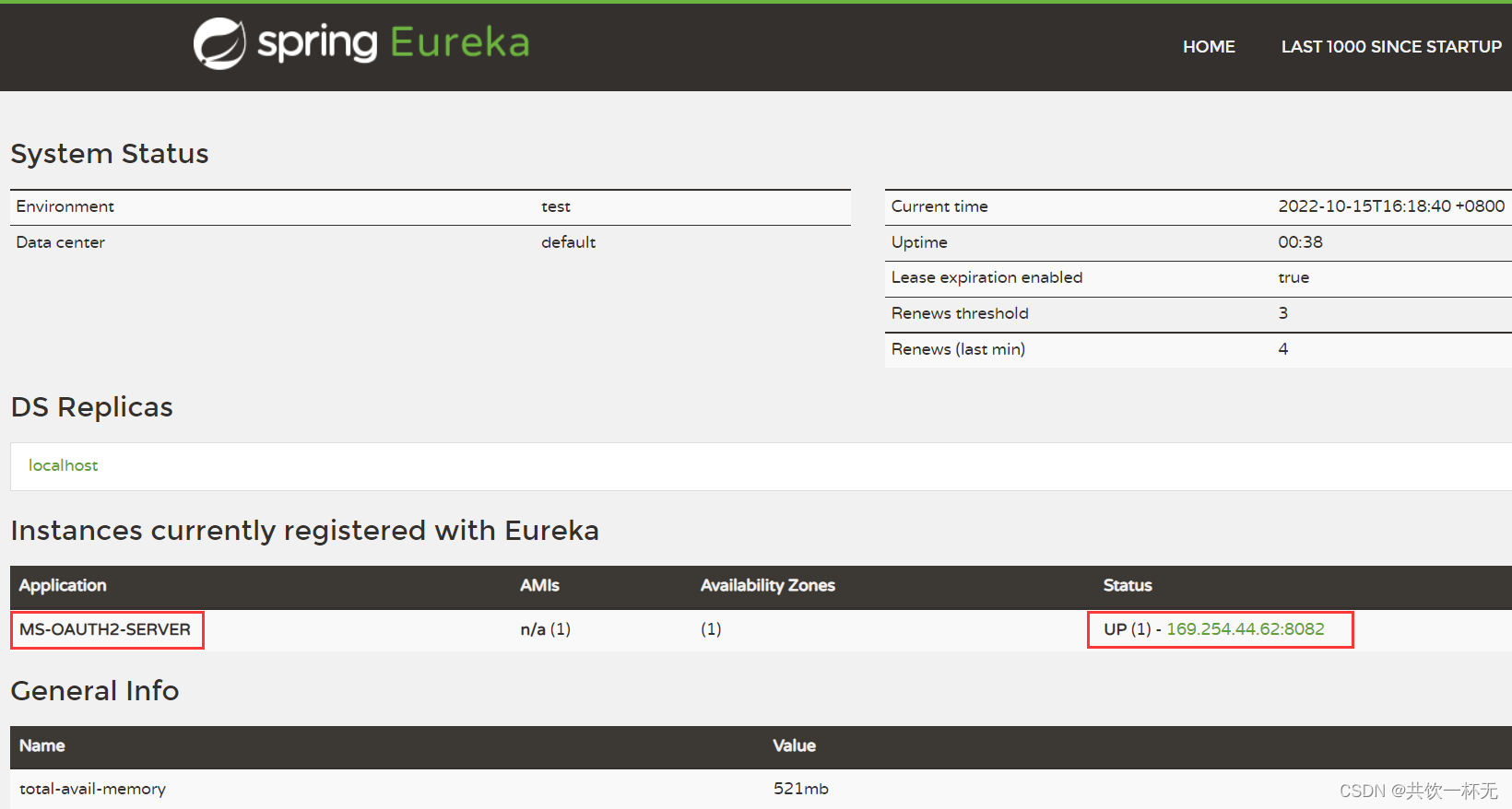
接下来我们通过postman访问请求token测试:
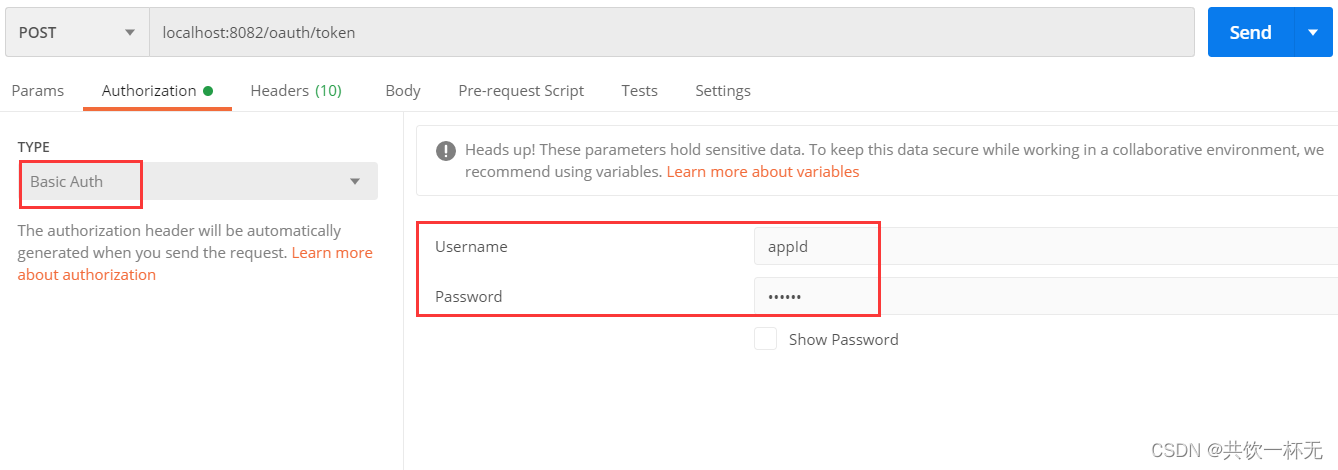
Authorization请求头中配置,username和password,对应oauth客户端中的配置:
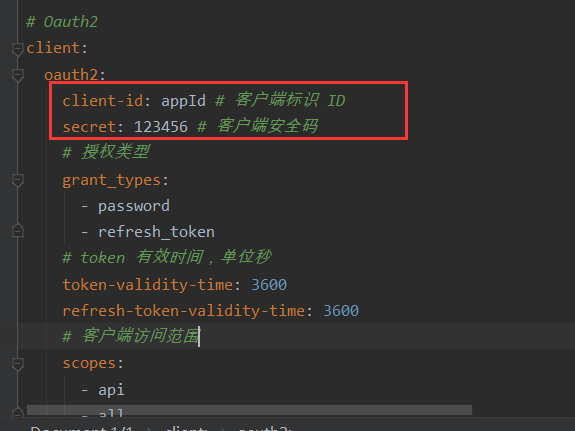
在body中配置请求参数,发起请求后返回如下:
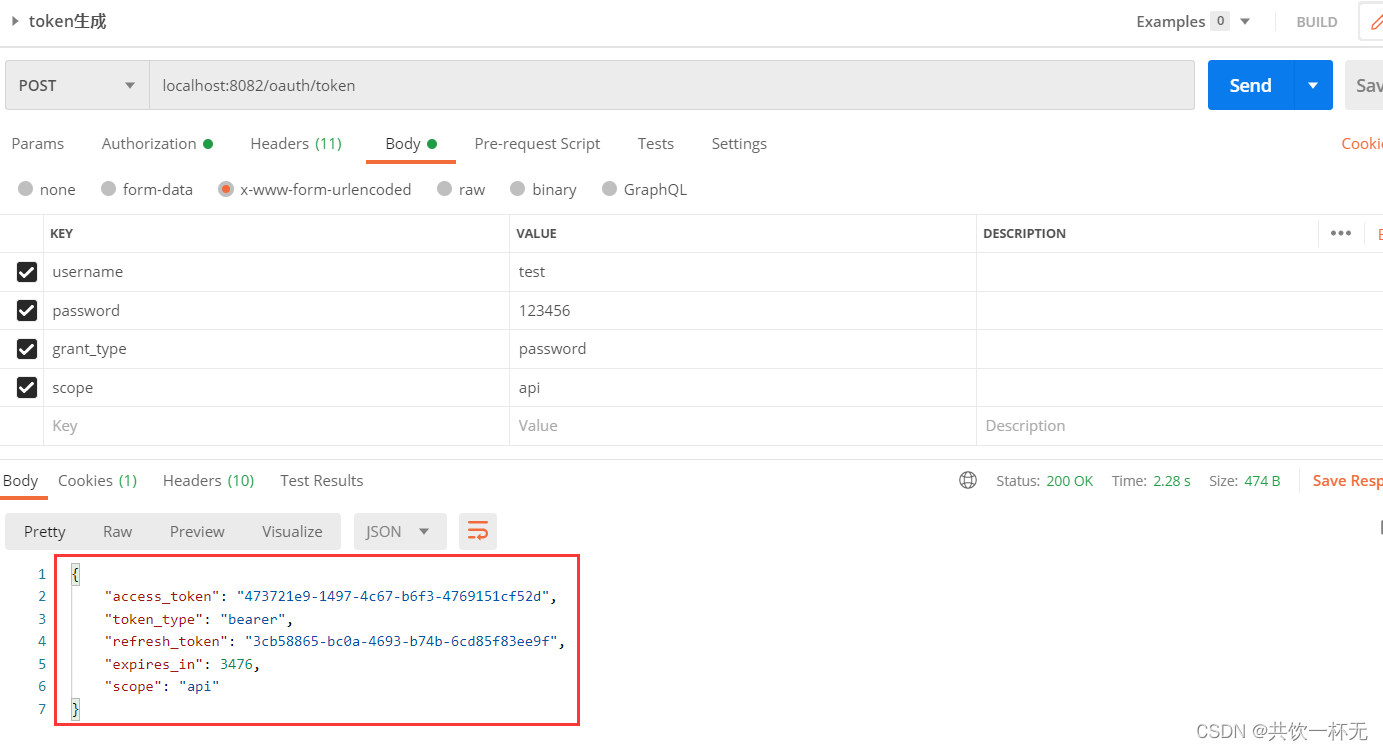
在Redis中我们也可以看到生成的相关token配置:
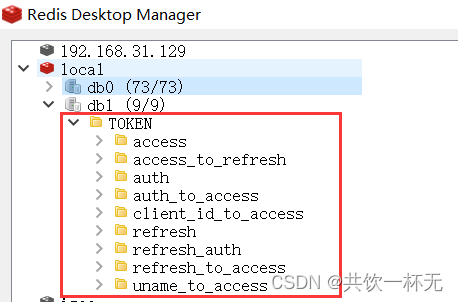
至此,我们完成了认证授权中心的初步搭建。
本文内容到此结束了,
如有收获欢迎点赞👍收藏💖关注✔️,您的鼓励是我最大的动力。
如有错误❌疑问💬欢迎各位指出。
主页:共饮一杯无的博客汇总👨💻
保持热爱,奔赴下一场山海。🏃🏃🏃














